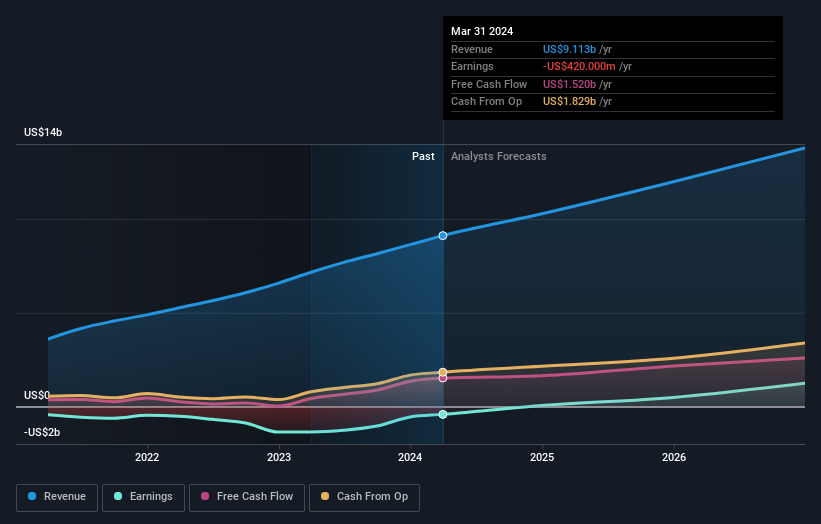- United States
- /
- Hospitality
- /
- NasdaqGS:DASH
DoorDash, Inc. (NASDAQ:DASH) Just Released Its First-Quarter Earnings: Here's What Analysts Think

It's been a sad week for DoorDash, Inc. (NASDAQ:DASH), who've watched their investment drop 13% to US$114 in the week since the company reported its first-quarter result. Revenues of US$2.5b beat expectations by a respectable 2.5%, although statutory losses per share increased. DoorDash lost US$0.06, which was 26% more than what the analysts had included in their models. Earnings are an important time for investors, as they can track a company's performance, look at what the analysts are forecasting for next year, and see if there's been a change in sentiment towards the company. We thought readers would find it interesting to see the analysts latest (statutory) post-earnings forecasts for next year.
Check out our latest analysis for DoorDash

Following the latest results, DoorDash's 36 analysts are now forecasting revenues of US$10.3b in 2024. This would be a notable 13% improvement in revenue compared to the last 12 months. Earnings are expected to improve, with DoorDash forecast to report a statutory profit of US$0.14 per share. Before this earnings report, the analysts had been forecasting revenues of US$10.2b and earnings per share (EPS) of US$0.24 in 2024. So there's definitely been a decline in sentiment after the latest results, noting the large cut to new EPS forecasts.
It might be a surprise to learn that the consensus price target was broadly unchanged at US$133, with the analysts clearly implying that the forecast decline in earnings is not expected to have much of an impact on valuation. That's not the only conclusion we can draw from this data however, as some investors also like to consider the spread in estimates when evaluating analyst price targets. The most optimistic DoorDash analyst has a price target of US$170 per share, while the most pessimistic values it at US$107. There are definitely some different views on the stock, but the range of estimates is not wide enough as to imply that the situation is unforecastable, in our view.
Of course, another way to look at these forecasts is to place them into context against the industry itself. We would highlight that DoorDash's revenue growth is expected to slow, with the forecast 17% annualised growth rate until the end of 2024 being well below the historical 29% p.a. growth over the last three years. By way of comparison, the other companies in this industry with analyst coverage are forecast to grow their revenue at 9.7% annually. Even after the forecast slowdown in growth, it seems obvious that DoorDash is also expected to grow faster than the wider industry.
The Bottom Line
The most important thing to take away is that the analysts downgraded their earnings per share estimates, showing that there has been a clear decline in sentiment following these results. Happily, there were no major changes to revenue forecasts, with the business still expected to grow faster than the wider industry. The consensus price target held steady at US$133, with the latest estimates not enough to have an impact on their price targets.
With that in mind, we wouldn't be too quick to come to a conclusion on DoorDash. Long-term earnings power is much more important than next year's profits. We have estimates - from multiple DoorDash analysts - going out to 2026, and you can see them free on our platform here.
You should always think about risks though. Case in point, we've spotted 2 warning signs for DoorDash you should be aware of.
New: Manage All Your Stock Portfolios in One Place
We've created the ultimate portfolio companion for stock investors, and it's free.
• Connect an unlimited number of Portfolios and see your total in one currency
• Be alerted to new Warning Signs or Risks via email or mobile
• Track the Fair Value of your stocks
Have feedback on this article? Concerned about the content? Get in touch with us directly. Alternatively, email editorial-team (at) simplywallst.com.
This article by Simply Wall St is general in nature. We provide commentary based on historical data and analyst forecasts only using an unbiased methodology and our articles are not intended to be financial advice. It does not constitute a recommendation to buy or sell any stock, and does not take account of your objectives, or your financial situation. We aim to bring you long-term focused analysis driven by fundamental data. Note that our analysis may not factor in the latest price-sensitive company announcements or qualitative material. Simply Wall St has no position in any stocks mentioned.
About NasdaqGS:DASH
DoorDash
Operates a commerce platform that connects merchants, consumers, and independent contractors in the United States and internationally.
Flawless balance sheet with reasonable growth potential.
Similar Companies
Market Insights
Community Narratives



